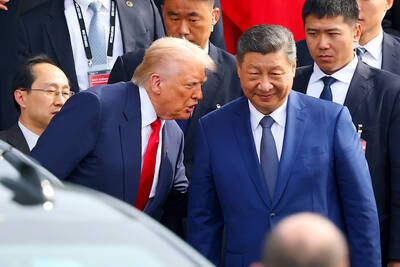The US on Tuesday announced that it has approved the sale of up to US$95 million of training and equipment to support Taiwan’s Patriot missile defense system, something Taipei said would help protect the nation from any invasion by China.
“The proposed sale will help to sustain [Taiwan’s] missile density and ensure readiness for air operations,” the Pentagon’s Defense Security Cooperation Agency said in a statement.
It added that Taiwan would use the proposed training and equipment as a “deterrent to regional threats and to strengthen homeland defense.”

Photo courtesy of Ministry of National Defense via CNA
The Ministry of Foreign Affairs welcomed the arms deal — the third approved by US President Joe Biden’s administration.
“In the face of China’s continuing military expansion and provocation, Taiwan must fully demonstrate its strong determination to defend itself,” the ministry said in a statement.
“Our government will continue to strengthen our self-defense and asymmetric combat capabilities,” it added.
The Ministry of National Defense said the deal is expected to take effect in one month.
The latest arms purchase comes as Taiwan closely watches the ongoing Russia-Ukraine war, as it also lives under the constant threat of an invasion by a giant neighbor.
The Chinese Ministry of Foreign Affairs yesterday condemned the deal, saying it “severely harms US-China relations, and the peace and stability of the Taiwan Strait.”
“China will take resolute and forceful measures to resolutely defend its own sovereignty and security interests,” ministry spokesman Zhao Lijian (趙立堅) said.
China has sanctioned US defense giants — including Boeing Defense, Lockheed Martin and Raytheon — for selling arms to Taiwan.
Beijing has ramped up its saber-rattling in recent years, sending 969 Chinese warplanes into Taiwan’s air defense identification zone last year, according to a database compiled by Agence France-Presse — more than double the roughly 380 in 2020.
Taiwan has recorded about 280 warplanes entering the zone this year.
Western powers, as well as regional neighbors Japan and South Korea, have looked on with growing alarm at Beijing’s designs on Taiwan under Chinese President Xi Jinping (習近平).
On Tuesday, Australia announced that it was accelerating plans to buy long-range missiles, citing new threats posed by Russia and China, including a potential invasion of Taiwan.
“There was a working assumption that an act of aggression by China toward Taiwan might take place in the 2040s. I think that timeline now has been dramatically compressed,” Australian Minister for Defence Peter Dutton told Seven Network television.
Washington has remained Taipei’s most important ally and leading arms supplier, despite switching diplomatic recognition to Beijing in 1979.
The Patriot is a highly mobile surface-to-air missile system that would be a crucial defense against Chinese warplanes.
Former US president Donald Trump ramped up big-ticket arms sales to Taiwan during his time in office as he feuded with Beijing on a host of issues from trade to national security.
Sales included drones, missile systems and new-generation fighter jets.

CALL FOR SUPPORT: President William Lai called on lawmakers across party lines to ensure the livelihood of Taiwanese and that national security is protected President William Lai (賴清德) yesterday called for bipartisan support for Taiwan’s investment in self-defense capabilities at the christening and launch of two coast guard vessels at CSBC Corp, Taiwan’s (台灣國際造船) shipyard in Kaohsiung. The Taipei (台北) is the fourth and final ship of the Chiayi-class offshore patrol vessels, and the Siraya (西拉雅) is the Coast Guard Administration’s (CGA) first-ever ocean patrol vessel, the government said. The Taipei is the fourth and final ship of the Chiayi-class offshore patrol vessels with a displacement of about 4,000 tonnes, Lai said. This ship class was ordered as a result of former president Tsai Ing-wen’s (蔡英文) 2018

UKRAINE, NVIDIA: The US leader said the subject of Russia’s war had come up ‘very strongly,’ while Jenson Huang was hoping that the conversation was good Chinese President Xi Jinping (習近平) and US President Donald Trump had differing takes following their meeting in Busan, South Korea, yesterday. Xi said that the two sides should complete follow-up work as soon as possible to deliver tangible results that would provide “peace of mind” to China, the US and the rest of the world, while Trump hailed the “great success” of the talks. The two discussed trade, including a deal to reduce tariffs slapped on China for its role in the fentanyl trade, as well as cooperation in ending the war in Ukraine, among other issues, but they did not mention

HOTEL HIRING: An official said that hoteliers could begin hiring migrant workers next year, but must adhere to a rule requiring a NT$2,000 salary hike for Taiwanese The government is to allow the hospitality industry to recruit mid-level migrant workers for housekeeping and three other lines of work after the Executive Yuan yesterday approved a proposal by the Ministry of Labor. A shortage of workers at hotels and accommodation facilities was discussed at a meeting of the legislature’s Transportation Committee. A 2023 survey conducted by the Tourism Administration found that Taiwan’s lodging industry was short of about 6,600 housekeeping and cleaning workers, the agency said in a report to the committee. The shortage of workers in the industry is being studied, the report said. Hotel and Lodging Division Deputy Director Cheng

‘SECRETS’: While saying China would not attack during his presidency, Donald Trump declined to say how Washington would respond if Beijing were to take military action US President Donald Trump said that China would not take military action against Taiwan while he is president, as the Chinese leaders “know the consequences.” Trump made the statement during an interview on CBS’ 60 Minutes program that aired on Sunday, a few days after his meeting with Chinese President Xi Jinping (習近平) in South Korea. “He [Xi] has openly said, and his people have openly said at meetings, ‘we would never do anything while President Trump is president,’ because they know the consequences,” Trump said in the interview. However, he repeatedly declined to say exactly how Washington would respond in